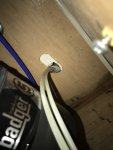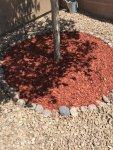- May 23, 2015
- 24,543
- Pool Size
- 16000
- Surface
- Plaster
- Chlorine
- Salt Water Generator
- SWG Type
- Pentair Intellichlor IC-60
Hmm, I have a mystery valve under my kitchen sink, unused. I suspected it was either hard or soft (depending on what the sink is connected to). But I haven't figured out how to know, nor why it would be there. I guess I could test it with my trusty K-2006! I thought maybe the kitchen had both hard and soft so that one could be for the dishes (soft water for the main faucet) and the other could be for a filtered drinking water faucet (hard water for those that don't want to consume soft water). I'll have to figure it out.
My city water tastes so bad, I added the whole-house filter plus an RO under the kitchen sink. I plumbed the refrigerator's ice maker to the RO, which has it's own filter, so I can get tripled filtered water at the fridge if I want.
I didn't realize my under sink RO was using water to make water. Is that a given? Or do different models do it differently? I only use that for drinking, cooking and ice, so hopefully I'm not wasting too much. I do my dishes in unfiltered water.
If it is truly a reverse-osmosis system, then, by definition, there must be a waste line. It’s usually a plastic 1/4” line that’s hooked up to your sink waste pipe with a saddle clamp. If the RO unit doesn’t have a powered permeate pump (essentially a hydraulic powered water pump that pushes treated water back into the input line and raises the input pressure), then the efficiency will be very low - it takes multiple gallons of input water to produce a single gallon of RO water. RO is only efficient when the input pressure is high (> 150psi) and the water is pretreated to remove calcium and chlorine. Advanced whole house RO systems will either use a small salt based softener to pretreat the water OR they will use a Stenner pump to inject scale inhibitors (phosphonic acid) to control membrane scaling. Efficient whole house RO systems can easily run $10k-$15k to install and they usually require a 250-500 gallon water storage tank with a variable speed water pump to repressurize the water into the house supply. You can get very fancy with these systems but then you’re basically building a small-scale water treatment plant in your garage or basement. Not worth it at all in my opinion.








